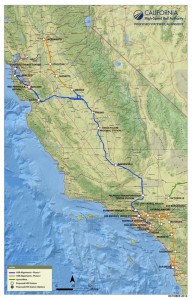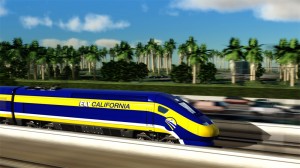Critics of high speed rail have tried to fight the system in court and sort of at the ballot box (failed Republican gubernatorial candidate Neel Kashkari made a big deal about Governor Brown’s “crazy train”). So far they have failed at both.
But a remaining criticism, that the state doesn’t have enough money to finish the system, still looms large. The funding reality is especially alarming given the unfortunate starting point in San Joaquin Valley no-man’s land, far from the state’s major urban centers and thus far from a political constituency that would be motivated to fight to finish the system.
The financial doomsday scenario I can imagine is pretty straightforward. The High Speed Rail Authority has less than $10 billion in voter-approved state bond funds and $3.5 billion in federal funds. It will also get about $250 million a year in cap-and-trade money, at least until 2020 (totaling roughly $1.5 billion). So that’s a grand total of approximately $14.5 billion, give or take a billion.
[UPDATE: some estimates for cap-and-trade auction revenue are as high as $8 billion by 2020, with high speed rail receiving 25 percent. So my estimate for the total take should probably be revised upward to possibly $8 billion or so through 2020.]
How much will that money build?
 Well, it should fully fund the “initial operating segment” of Phase 1, which will connect Madera to just north of Bakersfield. That segment will hopefully be completed around 2020 at a cost of $6 billion. So far so good. That leaves over $8 billion left, assuming no cost overruns (a baldly counter-historical assumption).
Well, it should fully fund the “initial operating segment” of Phase 1, which will connect Madera to just north of Bakersfield. That segment will hopefully be completed around 2020 at a cost of $6 billion. So far so good. That leaves over $8 billion left, assuming no cost overruns (a baldly counter-historical assumption).
Then the final construction on this segment will take the line an additional 170 miles north to Merced to and south to the San Fernando Valley in Los Angeles County, where the system will connect with Metrolink sometime in the 2020s. This link will be important for political support and ridership, as it will finally connect the system to an urban area, albeit on the outskirts and with the necessity of a transfer from the relatively slow Metrolink system.
But the problem is that this construction will cost an estimated $25.3 billion. That leaves California about $17 billion short of getting the system to a major metropolitan area, assuming no cost overruns. Not to mention that extending the line 110 miles north to San Jose will cost another $19.9 billion.
Where will the additional funds come from?
I think you can safely assume no more federal dollars at least until the 2020s, given expected Republican dominance of Congress until the new decade, due to state gerrymandering of congressional districts. And the State of California is unlikely to provide additional dollars, given the shortfall in our existing transportation system and voter unwillingness to pass another bond measure on top of the 2008 one. Perhaps private money might materialize, but that Los Angeles-to-Fresno route does not seem particularly lucrative. (The one bright spot may be the privately funded Las Vegas-to-Victorville line, which might one day provide money and political weight to connect to a Tehachapi crossing on the state-funded system.)
So by the early 2020s, the California High Speed Rail Authority could conceivably have spent billions of dollars to create a separate rail right-of-way along a pretty significant portion of the southern Highway 99 corridor. But it won’t have launched high speed service anywhere, let alone to a major population center. And all the money will have run out.
All would not totally be lost: that right-of-way could presumably be used for improved Amtrak service, which might even earn an operating profit. But unless the Authority has made progress on the great engineering challenge of getting the rail route over the Tehachapis to serve the politically connected Palmdale region, rather than the easier Grapevine approach, high speed rail boosters will need a renewed political push to raise the billions needed to connect the system to ‘someplace close’ to Los Angeles.
I could certainly imagine that political push happening, but it would be an uphill climb (no pun intended) against a record of billions of dollars spent without much to show for it. To be sure, as I wrote for the groundbreaking last week, I do believe high speed rail is inevitable and badly needed. But this doomsday scenario could put the brakes on the system for possibly decades to come.
I hope I’m wrong. But in the meantime, California leaders may want to consider far-cheaper and quicker upgrades to statewide Amtrak service and possibly spearhead private efforts to build a viable, standalone high speed rail segment, such as within the Los Angeles-to-San Diego corridor.
Because if my fears prove true, we could be on a slow speed to high speed for quite a while to come.
2 thoughts on “A Possible Financial Doomsday Scenario For California High Speed Rail”
-
Pingback: High Speed Rail Video From Bakersfield To Palmdale Just Imaginary Unless Private Investors Step Up | Ethan Elkind
-
Pingback: High-speed rail likely to abandon SoCal connection « The Berkeley Blog
Leave a Reply
You must be logged in to post a comment.



